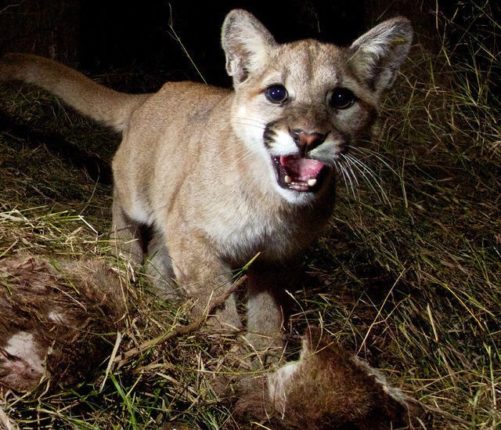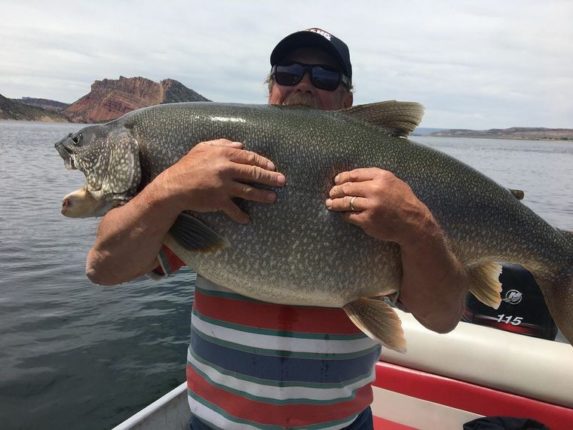With the first day of deer season starting in Southeast Idaho on Wednesday, frigid wintery precipitation wasn’t all that was falling to the ground.
At least a dozen fallen deer, shot by Southeast Idaho hunters, passed through the Idaho Fish and Game’s checkpoint at the weigh station along Interstate 15 just north of Inkom on Wednesday, according to Zach Lockyer, a wildlife manager for Idaho Fish and Game.
“About 50 people and about a dozen animals or so, including a moose, passed through the checkpoint today,” Lockyer said just after 1 p.m on Wednesday. “This morning has been a little interesting with the rain and snow. It was a little different of an opening day than in past years where it’s been 70 degrees and warm.”
Lockyer said the Southeast division of the Idaho Department of Fish and Game establishes a checkpoint at the weigh station near Inkom every opening day and for the following two weekends to get a better understanding of deer herd populations and to receive feedback from Southeast Idaho hunters.
“We always have our check station here to give us the first glimpse of what the hunting season is going to be like,” Lockyer said. “It also gives us some face time with hunters to understand what they are dealing with and to receive any ideas they may have for potential changes.”
In addition to meeting with hunters for a sense of what the season may hold, Lockyer said officials also look at the health and quality of the deer population.
Lockyer added that Fish and Game officials at the checkpoint make an incision on the neck of many of the deer to collect lymph nodes that will later be tested for chronic wasting disease, a neurological condition that affects deer, elk, reindeer, sika deer and moose.
Moreover, Lockyer said Fish and Game officials host the checkpoint to get a better sense of the success rate for hunters going out on opening day.
“We keep track of the people who didn’t get an animal and the ones who did,” Lockyer said. “We also get a sense for the quality of deer that people are seeing and harvesting. We look to see if it’s a bunch of young, skinny deer or if it’s larger bucks. The checkpoint gives us that first pulse on how the deer herds are doing and how the hunters are faring.”
One hunter who had success on opening day, Annie Mowrey, of Pocatello, said she had expected to stay out all weekend in search of her deer. But with a little luck and the right conditions, she was able to fill her tag before 10 a.m. Wednesday.
Mowrey only recently took up the sport of hunting after she learned from her doctor that she needed to remove beef from her diet for medical reasons.
“I am not supposed to eat beef anymore, but we raise our beef on our ranch and farm in Pocatello,” Mowrey said. “(My husband) always hunted and so I said, ‘Well if I can’t eat beef, then maybe I’ll go get a deer.’”
Mowrey is two for two in her deer hunting adventures, landing one last year in addition to the three-point buck she got on Wednesday.
“He’ll be dinner tonight,” Mowrey said. “Now the hard work is about to start.”
Unlike many who hang harvested animals for seven to 10 days before butchering, Mowrey said it’s her family’s preference to butcher right away, as it keeps the meat from tasting super gamy.
Mowrey shot the buck near Downey, staying with relatives overnight on Tuesday night and hitting the hillsides early Wednesday morning. She said the inclement weather definitely played a significant role in her hunting strategy.
“With the weather this morning we didn’t know if it was going to force them down into the lower country or if we should head into the high country,” Mowrey said. “We decided to try the low-country with as much snow and rain that we got last night.”
Mowrey said she worked some of the smaller draws in the Downey area and just happened to come across a small herd.
“We were able to come up the draw and they didn’t realize we were there, of course,” Mowrey said. “We got on top of the hill country that we were in. I got set up, waited for him to turn broadside and got blessed this morning.”
Compared with beef, Mowrey said deer meat is much leaner and has no hormones, chemicals or antibiotics that can oftentimes be found in store-bought beef products.
“No nothing,” she said. “They don’t have any saturated fats. It’s a much healthier red meat, which is nice, because I wasn’t willing to give up the red meat.”
Mowrey used a 6.5 Creedmoor rifle — a gun she said is the perfect midsize firearm.
“It’s a good female gun,” she said. “They’ve got decent knockdown power. You can take down a deer or an elk with that gun and it doesn’t clobber your shoulder.”
Lockyer told the Journal that one moose, in addition to the dozen or so deer, passed through the checkpoint on Wednesday, adding that a limited number of moose and elk tags were issued in the region.
“But the majority of hunters out today are deer hunters,” Lockyer said. “Most hunts in this region in the southeast part of the state are buck only. After that bad winter we had two years ago, we closed some of our doe hunting to give them a chance to rebound, so there are very few doe tags out there.”
Mowrey said her next hunt is to fill an elk tag that opens on Oct. 25. Her husband, Jim Mowrey, is planning for an archery hunt that starts Nov. 16. Though they both have their sights set on future harvests, Annie Mowrey spent the rest of Wednesday soaking up the opening day success.
“It’s been a great morning,” she said. “We’ll have meat for quite a while, which is pretty cool.”
She continued, “It’s quite a blessing. There have been times where you’ll search for an an animal to harvest all season and not get the opportunity. So to get him on opening day is just a blessing. I’m super stoked.”







